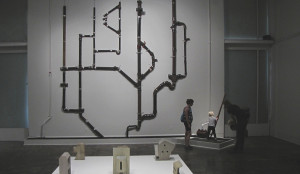
Michael Bartalos, Galen Jackson, Eleanor Oakes, Ben Peterson and Anja Ulfeldt are showing multimedia, cross-disciplinary work in “Half Tilt Full Lean,” an exhibition running through June 15 at the Thomas Welton Stanford Art Gallery, near the northeast corner of the Quad.
The work is conceptual and intellectual, but also humorous and socio-politically driven. The statement by the show’s curator, Stanford Art Professor Enrique Chagoya, entitled “Ontology of the Sublime (What the…?),” sets the tone, with a philosophical dialogue between Sublime and Ontology that is clearly modeled on Oscar Wilde’s cleverly paradoxical model. Sublime claims, for example, that art is not limited to “the thingly thingness of the thing,” adding, “Also I am not sure one can say that there is a beingness in art.” But fear not: Chagoya’s insights into his students’ works, expressed in his “humble clear, precise, concise and profound style,” are informative, even when read onscreen.
Bartalos’s “Phase Transition” is a sculptural installation featuring long strips of silvery Mylar tape, draped from nails in loops and swags that may suggest audiocassette tape or film projectors. Illuminated by theatrical red, blue and green lamps, the loops create multicolored auroral reflections that are hypnotically beautiful, though charged with subtext: the tape replicates a 1450-year graph depicting Arctic ice levels, ending with “the Mylar’s final and precipitous drop to the floor.” Bartalos sees this piece as representing our and nature’s “perpetual state of vulnerability and transformation.”
Jackson’s three untitled installations are enigmatic stage sets that suggest dioramas or museum theme rooms, but he parodies instead of commemorating nerd-genius scientific research in a capitalist economy— issues that are certainly au courant on the Farm. The artist recruits products of outmoded technology for his absurdist “narrative-centric art cinema,” including 50-gallon oil drums marked “lityum dirt and effluents,” tangles of extruded VHS tape, photographs and phonographs, slide carousels, game controllers, scrolls of bubble wrap, suitcases, thrift-store easy chairs, stacks of boxy CRT monitors and cartons of “lithuril lityum karbonat” capsules.
Oakes’ video diptych, “Barnes Hall, 2012-14” (presumably referring to a Cornell dorm) comprises two angled video screens presenting slightly different, slowly changing views of what appears to be the night sky, filled with stars and cosmic dust. The size and ambiguous subject matter suggest Abstract Expressionist painting, but a more relevant artistic antecedent might be “Dust Breeding,” Man Ray’s famous 1920 photograph of Marcel Duchamp’s Large Glass after a year in storage. Oakes takes the “dead cells and strands of hair” that go trailing behind us every day and makes animated “dustograms” in the darkroom, poetic bridges, says Chagoya, “between the micro-cosmic and the infinite.”
Peterson’s nine painted ceramic sculptures from the“Cynics” series resemble small blocky maquettes for monumental abstract sculptures, but also suggest Brutalist concrete architecture, Ikea-style Modernist furniture and, with their oddly placed cavities, the ubiquitous styrofoam packing materials protecting consumer goods.
Ulfeldt’s sculptures with sound derive from her experience living in industrial parts of the Bay Area and her interests in ambient noise and temporality: “I want my installations to exist in their own perpetual moment, creating a collective durational experience while remaining urgently present.” “Street Lamp” pairs a yellow sodium–bulb streetlight, centered beneath the gallery lobby’s dome, with streaming traffic sounds from Oakland. “Domestic Infrastructure #2,” composed of a network of recycled cast-iron pipes mounted to the wall, resembles a flow diagram, and functions as such when viewers manually pump water to the top, causing the rust-discolored fluid, with its sound amplified, to gurgle and rush downward, staining the walls.
Contact Dewitt Cheng at dewittc “at” stanford.edu.
